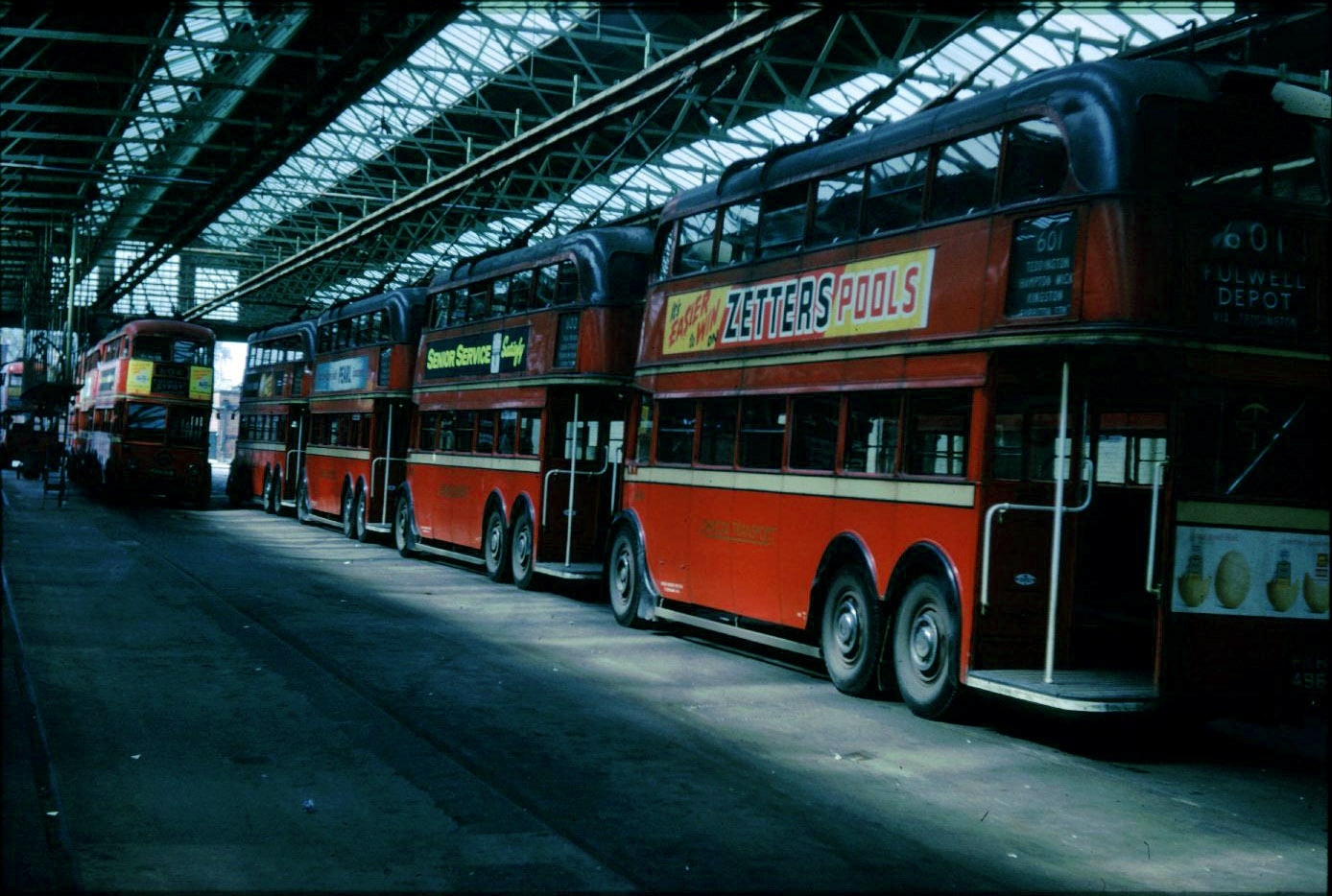
Inside London Trolleybus Depot at Fulwell
 |
| Click on picture [333] for an enlarged version |
Notes by David Bradley
This picture of Fulwell Depot was taken on the morning of 8 May 1962,
the last day of operation of London's Trolleybuses. Exactly why these vehicles were not out on the road I am not sure
and I now wonder if they ever saw service again. If this was the end of their service life, then they would next be
moved onto the depot forecourt to await a tow to their grave in Colindale.
It is often said that the demise of the trolleybus was due to the
inflexibility of route modifications and their high cost of replacement. To this day I have no idea of the running cost
of a trolleybus nor its replacement cost against a diesel equivalent in the early 1960s - if you know, please let me know.
Environmental issues today would probably have ensured their future had they remained, except that the overhead wiring
infrastructure would have, perhaps, needed complete replacement by now.
Just as a footnote, some bus stops now have electronic displays for the
duration before the next bus arrives. In 1959 it was simply a case of placing your ear against a support pole to hear if
a vehicle was in the vicinity! A low tech solution in the days when **nobody** had a mobile phone.
From: "Roger Rettig" <rogerrettig@hotmail.com>
The depots always fascinated me. They were the real targets for me when my Mother would send me off on a Saturday with
sandwiches and 2/6d for a Red Rover! This was 1955 and Wood Green had some withdrawn 'C1s' parked on the southern wall,
Poplar had those STLs hidden away and Highgate was glorious!! Two entrances helped to thwart the most eagle-eyed LT
employee [I always felt they were hired JUST to spoil my fun] and three rows of withdrawn vehicles - including 1379(!!!)
with it's dual rear doors.
It was inside the depots where I learned the most about London's trolleybuses; do you remember how little information
there was available to us? The Ian Allen ABCs were the fount of all official knowledge and I'll never forget standing
at Shepherds Bush for over six hours secure in the knowledge that 1671 - the twin front axled X7 - HAD to show up
eventually on the 607 - because there was a picture of her at that very spot in the current edition! [She was,
of course, long since withdrawn - spurned by HL's drivers because of her heavy steering; common sense eventually
prevailed and I found her, dusty and magnificent, hidden in the depths of Hanwell Depot awaiting her one-way tow
to Bird's of Stratford and oblivion ...]
All this, and that unforgettable smell of ozone and rubber, with the characteristic sounds - motor generators, resistances
and swishing trolley heads - amplified and echoing around their cavernous domains. No bus garage ever came close.
From: "Ken" <ktudd@trolleybus.net>
I have just come across the picture taken inside Fulwell Depot and you were wondering why the
trolleys were lined up for.
The reason is that they were spread over buses and they were lined up ready for the afternoon service, some of them
did not go on the road until 4.56pm. Buses that were not needed were taken to the scrap area but there were 5
or 6 kept inside and, if my memory serves me right, there were 2 facing the 667 side, with blinds set and the others
were facing the 601 side.
Hope this is helpful.
From: "Clifford Hall" <cliffhall20@hotmail.com>
I've just found the web page with your splendid photos of trolleybuses, pure nostalgia.
I was born in Twickenham so used them very often, including the "Diddlers" on the 601 route before the
"Q" type came along, which I then used to go to school on, which was opposite Fullwell depot.
My step farther, Mr G S Stacey, as senior driver drove the first trolleybus into service when he was with LUT. He started
off as a point boy at Kingston Bridge, progressed to become conductor then driver on the trams until he transferred to
trolleys. As senior driver he drove the experimental vehicles when they came to Fullwell. In all he spent 50 years with
LUT/LT. He was asked to come out of retirement to drive the "Diddler" on the last day of trolleybus operations
in London, but he refused for some reason. He used to tell me lots of stories about his life on the trams/trolleys, oh
how I wished that I had recorded them, alas all lost now, but I do have his cap badges.